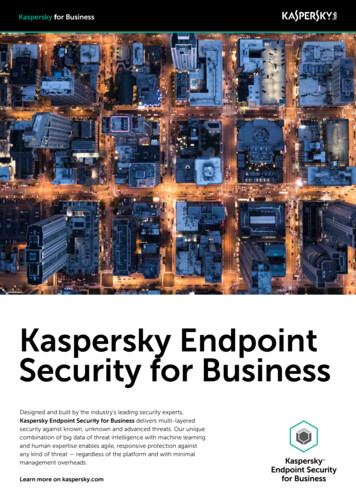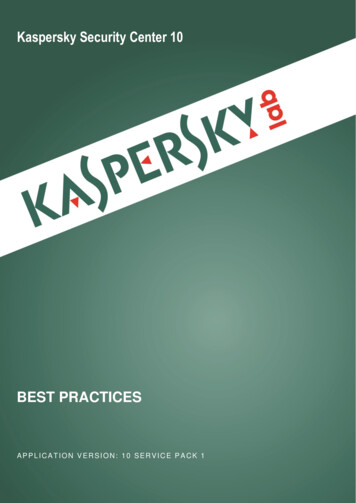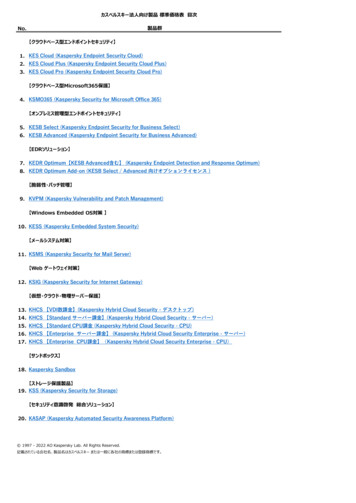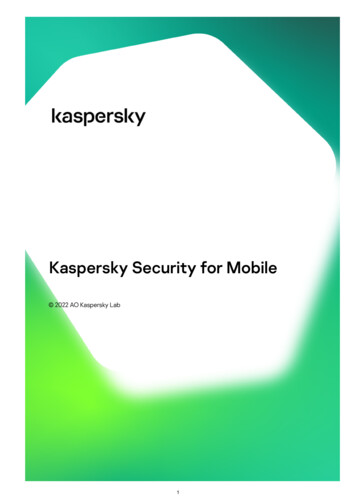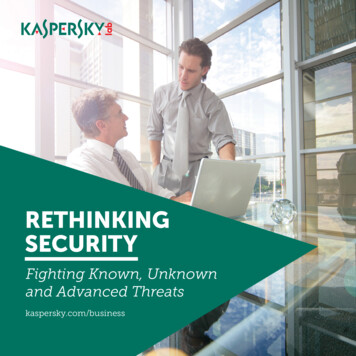
Transcription
RETHINKINGSECURITYFighting Known, Unknownand Advanced Threatskaspersky.com/business
REAL DANGERSAND THE REPORTEDDEMISE OF ANTIVIRUSRegardless of its size or industry, your business is in real danger of becoming a victim of“Merchants, he said, are either not runningantivirus on the servers managing pointof-sale devices or they’re not being updatedregularly. The end result in Home Depot’scase could be the largest retail data breachin U.S. history, dwarfing even Target.” Pat Belcher of Invincea1cybercrime. This fact is indisputable. Open a newspaper, log onto the Internet, watch TV newsor listen to President Obama’s recent State of the Union address and you’ll hear about anotherwidespread breach. You are not paranoid when you think that your financial data, corporateintelligence and reputation are at risk. They are and it’s getting worse.Somewhat more controversial, though, are opinions about the best methods to defend againstthese perils. The same news sources that deliver frightening stories about costly data breachesquestion whether or not anti-malware or antivirus (AV) is dead, as reported in these articlesfrom PC World, The Wall Street Journal and Fortune magazine.Reports about the death by irrelevancy of anti-malware technology miss the point. Smartcybersecurity today must include advanced anti-malware at its core. It takes multiplelayers of cutting edge technology to form the most effective line of cyberdefense.This eBook explores the features that make AV a critical component of an effectivecybersecurity strategy to fight all hazards targeting businesses today — includingknown, unknown and advanced cyberthreats.1. Mike Mimoso, Threatpost, “Feared Home Depot Breach SparksMore Interest in Backoff PoS Malware,” September, 2014, arks-moreinterest-in-backoff-pos-malware/108083
KNOWNTHREATSDuring 2013 and 2014, Kaspersky Lab detected approximately 315,000 malicious sampleseach day. From online attacks, malicious URLs and other nasty objects including scripts,Web pages, exploits and executable files, Kaspersky Lab estimates that 80 percent of thesecyberthreats fall under the heading of “known” threats.Although known malware is prevalent and perceptible, it is not innocuous. Older, wellknown malware is often used to launch more sophisticated, targeted attacks. This ispossible because many systems do not have proper or regularly updated security in place,third-party applications are outdated and long known vulnerabilities are not patched.Some of the most well-known data breaches began with simple malware. If not detectedand removed, malware can weaken the security perimeter and expose your business toadvanced threats that lead to loss of valuable financial and personal data and corporateintelligence — putting your organization’s reputation at risk.Kaspersky Lab solutions repelled367,431,148attacks launched from online resourceslocated all over the world.22. Kaspersky Lab, Kaspersky Security Network, 2014
AV’S ROLE INFIGHTINGKNOWN THREATSFrom the moment a Web page is opened, a file is downloaded or an application launched,Kaspersky Lab’s anti-spam engine also adopts a multi-layered approach, using severalKaspersky Lab’s advanced anti-malware engine kicks into gear to simultaneously check,techniques to identify and manage unwanted messages. All incoming mail is scanned,detect and protect against known, unknown and advanced Web and mail-based viruses,filtered and sorted for unwanted messages — according to administrator-defined policiesTrojans, rootkits, worms, spyware, scripts, adware and other known malicious objects andand settings. Reputational analysis, keyword/phrase and malicious or phishing links arethreats, using the following AV features:all used to identify spam messages. Messages are further evaluated based on analysis of boththe content and the mail’s service information. Heuristic analysis of mail headers providesA Network Attack Blocker scans all network traffic, using known signatures todetect and block network-based attacks, including port scanning, denial-of-service (DoS)attacks, buffer overruns and other remote malicious actions launched against programsand services running within the network. Traffic from attacking computers is blocked andinfected systems on the network are prevented from distributing their payload by havingtheir IP addresses blocked. Attack signatures are included in Kaspersky Lab’s antivirusdatabases and are regularly updated.URL Filtering scans and checks URLs in inbound/outbound traffic againstKaspersky Lab’s database of known malicious and phishing sites. Anything on thisblacklist of malicious sites is blocked, preventing Web-based attacks, server-sidepolymorphic malware and botnet command and control (C&C) servers.details of source server, AV scan status, application used to create the message and level ofurgency applied. Embedded and attached images are analyzed and compared with spampatterns in Kaspersky Lab’s signature database.This regularly updated database is further strengthened by Kaspersky Lab’s uniqueUrgent Detection System (UDS), which blocks even the newest and fastest-spreadingspam through the creation of real-time, anonymized connections to Kaspersky Lab’santi-spam laboratory servers. This means protection is provided instantly, without theneed to wait for the regular updates.
KASPERSKY LAB’S ANTI-SPAM ENGINE WORKS ON MULTIPLE LEVELSTO DETECT AND MANAGE UNWANTED, DANGEROUS MESSAGES.The Kaspersky Security Network (KSN) is one of the most important components ofKaspersky Lab’s multi-layered platform. KSN is a cloud-based, complex distributed infrastructurededicated to gathering and analyzing security threat intelligence from millions of Kaspersky Labusers’ systems worldwide. Administrators don’t have to train the anti-spam engine because adatabase of sample messages is already available.In Step 1, the volunteer participant in KSN’s systems can opt in to sendanonymized threat information to Kaspersky Lab’s analyst centers. Step2: Application-related threats and spam/embedded image data are sentto whitelisting and urgent detection system (UDS) databases, from whichKaspersky Lab users of these services will receive their intelligence (inStep 4). Step 3 shows heuristic threat analysis data being sent from analysts through to Kaspersky Lab’s signature database, from which usersreceive their regular threat and anti-malware updates.
Blacklisting enables organizations to automatically block all known malware, along withknown dangerous IP addresses and DNS. Kaspersky Lab’s dedicated teams of malware analystskeep databases up-to-date with the latest malware signatures and data.Instead of simply scanning executable files or scripts for malicious capability, the Scriptand File Emulator executes them in a safe, controlled environment that imitates a genuineoperating system and environment. Everything needed to make any file or script believe it’sexecuting in a real computing environment is there: memory, hard drive, registry, networkprocesses, subsystems, etc., so Kaspersky Lab’s technologies can take a detailed look at it andsee what it’s really up to.All file actions are tracked and sent for heuristic analysis. Because everything happens inan artificial environment, no malware can actually harm the computer. Any potentiallydangerous activities are weeded out prior to the file or script executing. The emulator datais yet another source of information used to keep the heuristic database up to date on thelatest threats. By executing them safely, it’s also possible to gain deeper intelligence into thebehavior and functionality of encrypted or packed objects. It’s also possible to generatesingle signatures for clusters of malware, enabling faster analysis and detection rates.33% of web attacks neutralizedby Kaspersky Lab products werecarried out using maliciousweb resources located in the US.33. Kaspersky Lab, Kaspersky Security Network, 2014
UNKNOWNTHREATSKaspersky Lab researchers estimate that 18 percent of cyberthreats fall under theKaspersky Lab ProvidesBest in the Industry ProtectionIN 2014 KASPERSKY LAB PRODUCTS PARTICIPATED IN 93 INDEPENDENTTESTS AND REVIEWS. OUR PRODUCTS WERE AWARDED 51 FIRSTS ANDRECEIVED 66 TOP-THREE FINISHES.category of “unknown” threats. To detect and remove these threats that have yet to beInformation security is in Kaspersky Lab’s DNA. The Kaspersky Security Network100%(KSN) has more than 60 million Kaspersky Security Network volunteers worldwide.This security cloud processes over 600,000 requests every second. Kaspersky users80%around the globe provide real-time information about threats detected and removed.Score of TOP3 placesidentified, businesses need to rely on a security provider with expert research at its core.Kaspersky LabThis data and other research are analyzed by an elite group of security experts –the Global Research and Analysis Team. Their main focus is the discovery andBitdefender60%analysis of new cyberweapons, along with the prediction of new types of threatsAviraworking in research and development. All solutions are developed in-house on a singleKingsoftSymantecBullguardSophosAhnLabPanda SecurityTencenttests. In calendar year 2014, Kaspersky Lab participated in 93 tests and reviews. Sixty-sixtimes Kaspersky Lab was named in the Top 3 and 51 times was rated first place.Trend MicroG DATA20%code base. Kaspersky Lab’s leadership and expertise is proven in multiple independentThreat Track (VIPRE)0%20ESETQihoo 36040%Kaspersky Lab is a technology-driven company with more than one third of employees1st places – 51Participation in 93tests/reviewsTOP 3 71%40MicrosoftIntel Security (McAfee)F-SecureAVGAvast60No. of independent tests/reviews80* Notes:According to summary results of independent tests in 2014 for corporate, consumer and mobile products.Summary includes tests conducted by the following independent test labs and magazines: AV-Comparatives,AV-Test, Dennis Technology Labs, MRG Effitas, NSS Labs, PC Security Labs, VirusBulletin. The size of the bubblereflects the number of 1st places achieved.100
KASPERSKY LAB’S MULTI-LAYERED, PROACTIVE TECHNOLOGIESANALYZE AND CHECK FILES AS THEY EXECUTE, USING PROACTIVEPROCESSES TO SEARCH FOR SUSPICIOUS OR MALICIOUS ACTIVITYTHAT SUGGESTS AN UNKNOWN THREAT IS AT PLAY, INCLUDING:IT’S A THREE-PRONGED APPROACH:1Kaspersky Lab’s Firewall: All packets entering and leaving the network are analyzedApplication startup controlgrants, blocks and audits application launches and drives productivity byrestricting access to non-business-related applications.and blocked/allowed accordingly. The firewall monitors all network connections, applyingpacket, application and network rules to them, depending on their specified status. Rulesbased on action, protocol, direction and address can be applied. Policies are applieddepending on network status: public, local, trusted. Unauthorized connections are blocked,2Application privilege controlregulates and controls application access to system resources and data,classifying applications as trusted, untrusted or restricted.decreasing the attack surface and possibility of infection. Infected or otherwise compromisedmachines have their network activity limited, reducing their ability to spread malware andlimiting damage caused by security policy violations.3Application vulnerability scanning and patch managementare proactive defenses against attacks targeted at vulnerabilities in trustedApplication Control and Whitelisting: Almost every program is vulnerable to bugs,applications. Kaspersky Lab’s application vulnerability control is optionalsome of which enable the execution of malicious code. These are security gaps that AVand disabled by default; it functions separately from the vulnerabilityservices or content filters can’t always cover – and criminals increasingly seek to exploit,assessment capabilities in Systems Management.particularly for launching targeted attacks against carefully chosen prey. Given that theaverage user has about 72 programs installed on their machine4, that’s a significant attacksurface. Kaspersky Lab’s application control and dynamic whitelisting enable proactivedefense from known and unknown threats by giving administrators complete control overthe applications and programs that are allowed to run, regardless of what the end user does.This includes preventing unpatched, vulnerable applications from running until they’reupdated. Application control blocks or allows administrator-specified applications, includingcontrolling how they behave – what resources they can use, what kind of user data they canaccess and modify, whether they write to registries etc. This means any application can beprevented from executing any action that could endanger systems or the network.4. Secunia, “Secunia Vulnerability Review,” March 2013
HOW KASPERSKY LAB’SAPPLICATIONCONTROL WORKSKASPERSKY LAB’S APPLICATION CONTROL IS UNDERWRITTEN BY DEFAULTDENY – A HIGHLY EFFECTIVE SECURITY STRATEGY THAT SIMPLY BLOCKSALL APPLICATIONS FROM RUNNING ON ANY ENDPOINT, UNLESS EXPLICITLYALLOWED BY ADMINISTRATORS. BLOCKED APPLICATIONS CAN BEQUARANTINED FOR ADMINISTRATOR APPROVAL.A Simplified Default Deny Algorithm
Application Controls and Default Deny reduce the risks posed by unknown threats.Most malware is delivered as an executable file that will not be found on any whitelist.Organizations that adopt this approach (and the supporting technologies) can thus preventany malicious file from executing, without needing to identify or know what those filesactually are.Criminals are constantly developing new technologies and techniques to gain access todata – by ensuring only trusted, patched applications are allowed to run on your systems,you’re adding an extra layer of defense.Effectively a global threat laboratory, Kaspersky Security Network (KSN) detects,analyzes and manages unknown or new threats and online attack sources in seconds – anddelivers that intelligence straight to customer systems. Working in concert with all the othercomponents of Kaspersky Lab’s engine, KSN enables the quickest reaction times and highestprotection levels possible. Newly-detected threats and malware are reported to the UrgentDetection System, which delivers the relevant intelligence through to KSN for widespreaddelivery. This enables protection from unknown threats before signatures are available — traditional signature-based responses can take hours; KSN takes about 40 seconds.Using real-time, anonymized data from 60 million volunteers globally, every file that passesthrough Kaspersky Lab protected systems is subject to analysis based on relevant threatintelligence – the same data ensures the most appropriate action is taken.12% of businesses surveyedby Kaspersky Lab reportedrun-ins with targeted attacks.5KSN is a good example of how the multi-layered approach to security works — with multiplecomponents working together or supporting other functionality to deliver symbiotic,comprehensive protection, even from unknown threats. It combines signature andheuristic malware detection with other Kaspersky Lab technologies such as whitelistingand application control.5. Kaspersky Lab, “Global IT Security Risks Report 2014,” November, 2014
ADVANCEDTHREATS107,215,793 unique URLswere recognized as maliciousby web antivirus components.7“Advanced” threats are complex attacks, consisting of many different components, includingpenetration tools (spearphishing messages, exploits etc.), network propagation mechanisms,spyware, tools for concealment (root/boot kits) and other, often sophisticated techniques, alldesigned with one objective in mind: to provide cybercriminals with undetected access tosensitive information.Advanced attacks target any sensitive data; you don’t have to be a government agency, majorfinancial institution or energy company to become a victim. Even small retail organizationshave sensitive client information on record; small banks operate remote service platforms forcustomers and businesses of all sizes process and hold payment information that is dangerousin the wrong hands. As far as attackers are concerned, size doesn’t matter: It’s all about theinformation. Even small companies are vulnerable to advanced threats – and need a strategyto mitigate them.Targeted and multi-component attacks are a steadily increasing trend — particularly whenit comes to businesses, where criminals are launching sophisticated, tailored attacks basedon well-researched organizational vulnerabilities. Twelve percent of businesses surveyed byKaspersky Lab reported run-ins with targeted attacks, with the combined costs of damages,remediation and other reactive spending averaging 2.54 million for enterpriseorganizations and 84,000 per mid-sized businesses.66. Kaspersky Lab, “Global IT Security Risks Report 2014,” November, 20147. Kaspersky Lab, Kaspersky Security Network, 2014
HOW KASPERSKY LABAV DETECTSADVANCED THREATSKaspersky Lab’s advanced threat detection technologies are designed to detect and block these,using a range of proactive, sophisticated heuristic scanning algorithms and behavior analyzers thatmonitor various file behaviors, discern suspicious patterns, block malicious activities and roll backharmful changes, including cryptors.Automatic Exploit Prevention (AEP) specifically targets malware that exploits softwarevulnerabilities. Even if a user downloads or opens a malicious file, Kaspersky Lab’s AEP technologywill prevent the malware from executing. Developed through in-depth analysis of the features andbehaviors of the most widespread exploits, the resulting technology is capable of identifyingexploit-characteristic behavior patterns – and blocking them from completion.Your file has been downloaded and started, 10 Kaspersky Lab technologies have scanned,analyzed, applied intelligence and variously blocked or allowed based on known as well asAEP’s capabilities include:unknown threats. But what about advanced threats? How do Kaspersky Lab’s technologiesControl of potentially vulnerablehandle advanced threats and other highly sophisticated malware – the kind that often hitsapplications: By focusing specifically on theat file execution stage?most targeted applications, such as AdobeReader , Oracle Java and Internet Explorer ,Complex, highly sophisticated exploits are invariably multi-layered, using a variety ofany attempt to launch unusual executable filestechniques to bypass more traditional security technologies. Many exploits target zero-dayor code via these programs, launches additionalvulnerabilities using techniques that can overcome even proactive protection technologies.security checks. Legitimate executables, suchThese are relatively low in number, but the damage caused by even one threat slippingas checking for updates, are accounted for.through the layers can be massive.But where certain characteristics of theexecutable file, along with any associatedKaspersky Lab’s reputation for discovering and mitigating against the most relevant,sophisticated threats, such as Epic Turla, Careto and Red October, are the result of this dedicationand commitment to research and development. Kaspersky Lab’s expertise is recognized andactions, are indicative of malicious activity,additional inspection will take place, followedby appropriate mitigating action.respected among top security organizations globally. Kaspersky Lab detects and remediates anymalicious activity; AEP technology tracks thisactivity and detects the source of the attemptto launch the code. Data on the most typicalexploit behaviors can help detect this kind ofactivity, even when a zero-day vulnerability isused – this means AEP doesn’t need to know theprecise nature of the exploit to understand thatmalicious activity is taking place.Tracking code origins: Some exploits –particularly those used in drive-by downloads(i.e. , launched though a malicious Web page) –need to retrieve their payload from anotherwebsite before executing it. AEP traces the originof such files, identifies the exact browser thatinitiated them and retrieves the remote Webattack, regardless of its origin or purpose, cooperating and consulting with law enforcement andMonitor pre-launch activities: How anaddress for the files. It’s possible for AEP togovernment officials around the globe.application launches or code executes and whatdistinguish between files created with userhappens before it does so, can reveal a lot aboutconsent and unauthorized ones – this inform-it. Certain kinds of behavior strongly indicateation can help identify exploits and block them.
Prevent exploits from accessing theirchosen vulnerability: Using a techniqueThe driver that intercepts file operationscalled Forced Address Space Layoutfor Kaspersky Lab’s AV component alsoRandomization with some programs andgathers information on changes made tosoftware modules, exploits can be preventedthe registry, while the firewall gathers datafrom finding the specific vulnerability oron the network activity of applications. All ofcode they need to execute, for example,this information is fed into System Watcherin memory. Repeated efforts to locate thewhich, in turn, has its own module capablerequired code are more likely to result in theof reacting to complex system events, suchapplication crashing than they are in theas installation of drivers.malicious code executing.and then demand a ransom in return for theCritical security issues related todecryption key. Rollback allows users to turnvulnerabilities in the Java platformback the clock to where their systems wereAEP acts like a safety net, an extra layer ofare managed by the Java2SW module.before the cryptor launched, restoring filessecurity that complements Kaspersky Lab’sMalicious actions, regardless of signaturefrom a backup copy automatically createdother technologies, such as antivirus andavailability, are blocked, with a low falseusing System Watcher.anti-spam filters.positive rate – destructive behavior patternsare the most reliable indicator of malware.Kaspersky System Watcher monitorsUrgent Detection System 2 (UDS2):elements, for which a hash sum is calculated;UDS2 builds on UDS’s known threat detectiona shingle is a combination of these sums.and collects data on application andThis continuous, detailed monitoring ofcapabilities, using a more advanced signatureUDS2’s cloud-based technology can cope withother important system activities. Thissystems enables exceptionally accuratecalled shingles to block new versions ofmore advanced spam-related threats becauseinformation is provided to the othersystem Rollback functionality, limitingspam containing subtle modifications thatit doesn’t require a perfect match betweenKaspersky Lab protection componentsthe impact of any infection and returningmay help it slip through the net. Kasperskyshingles to detect spam. Even modified spamdetailed here, providing a proactive securitysystems to previous, secure parameters.Lab’s technologies extend well beyond amessages can be blocked; combinations ofapproach. Any activity that correspondsRollback is particularly effective againstbasic endpoint security approach – layeredexisting shingles can be used to detect spamto threat patterns is dealt with accordingthe fast-growing class of malware knownsecurity protects each element in a layeredwithout requiring repeated re-assessments orto administrator-set policies (the defaultas cryptors or ransomware – whereinfrastructure, constantly filtering out threatsnew signature creation. This reduces responsesetting is to terminate the malicious processcriminals infect a system, encrypt importantand reducing the channels by which they cantimes and, crucially, drives more efficientand quarantine for later analysis if desired).documents without the user’s knowledgebe introduced. UDS2 ensures that messagesspam filtering –further reducing theare analyzed and divided into separatethreat surface.
STRATEGIESFOR COPINGWITH TARGETEDATTACKSAccording to KSN data, Kaspersky Labproducts detected and neutralized a total of1,325,106,041threats in the third quarter of 2014.11Many respected technology-focused organizations have already developed strategies forcoping with targeted attacks. Gartner, for example, has issued guidelines for dealing withApplication Whitelisting is the most valuable strategy any organization can adopt to fightsocial engineering techniques, including keeping pace with an evolving threat landscapeadvanced threats. It forms a powerful layer of protection against the executable componentsthrough ongoing information security education and educating users on the threatsof advanced threats, including as-yet-unknown threats. Interest in application control forposed by social engineering techniques.8desktops and servers has been increasing steadily over the last five years.Among the technical security issues addressed by Gartner, two key recommendationsKaspersky Lab’s solution implements Dynamic Whitelisting. Gartner has described properemerge: “Upgrade your perimeter and network-based security” and “Focus yourimplementation of Application Control as continuously updated from a cloud database –protection strategies on malicious content.” In this context, Gartner mentions Kasperskymaking it dynamic. Application Control with Dynamic Whitelisting can help protect systemsLab among the leading vendors for Application Control and Whitelisting, capable offrom both known and unknown threats by giving administrators total control over theproviding all the functionality needed to mitigate advanced threats.9applications that are allowed to run on endpoints, regardless of end-user behavior.108. Gartner, “Best Practices for Mitigating Advanced Persistent Threats,” September 12, 2013, mitigating-advanced-persistent9. Gartner, “How to Successfully Deploy Application Control,” January 25, 2013, eployapplication-control10. Gartner, “Competitive Landscape: Critical Infrastructure Protection,” December 16. 2013, dscape-critical-infrastructure-protection11. Kaspersky Lab, Kaspersky Security Network, 2014
WHY AV STILLMATTERS FOR KNOWN,UNKNOWN ANDADVANCED THREATSWhile no one is suggesting that signature-based anti-malware technologies, on their own,are enough to protect against an increasingly sophisticated and varied threat landscape,condemning them as useless puts your business at risk. In fact, sole signature-basedsoftware will not be viable for another 10 years, at least, which is why security solutionslike Kaspersky Lab’s have evolved into multi-layered security.According to the “2014 VerizonData Breach Report,” there were1,367 confirmed data breaches and63,437 security incidents in 2013.141,367confirmeddata breachesIn the second quarter of 2014, Kaspersky Lab’s anti-malware solutions detected 528,799,591virus attacks on end user systems, identifying a total of 114, 984, 065 unique maliciousobjects—or 114,984, 065 opportunities for a major data breach.12 According to the “2014Verizon Data Breach Report,” there were 1,367 confirmed data breaches and 63,437 securityincidents in 2013.13 The severity and cause of these incidents vary depending on the goalsof the cybercriminals and, sometimes, the size of the potential victim.With these odds, are you willing to take the risk of ignoring the benefits of AV?12. Kaspersky Lab, “Q3Threat Evolution Report 2014,” November, 2014, olution-q3-2014/13. Verizon, “2014 Verizon Data Breach Investigations Report,” http://www.verizonenterprise.com/DBIR/2014/14. Verizon, “2014 Verizon Data Breach Investigations 14/63,437securityincidents
TRY KASPERSKY LABABOUT KASPERSKY LABDiscover how Kaspersky Lab’s premium security can protect your business from malwareand cybercrime with a no-obligation trial. Register today to download full product versionsand evaluate how successfully they protect your IT infrastructure, endpoints and confidentialbusiness data.Get Your Free Trial TodayJOIN THE CONVERSATIONWatch us onYouTubeLike us onFacebookReviewour blogFollow us onTwitterKaspersky Lab is one of the world’s fastest-growing cybersecurity companies and thelargest that is privately-owned. The company is ranked among the world’s top four vendorsof security solutions for endpoint users (IDC, 2014). Since 1997, Kaspersky Lab has beenan innovator in cybersecurity and provides effective digital security solutions and threatintelligence for large enterprises, SMBs and consumers. Kaspersky Lab is an internationalcompany, operating in almost 200 countries and territories across the globe, providingprotection for over 400 million users worldwide. Learn more at www.kaspersky.com.Contact Kaspersky Lab today to learn more aboutKaspersky Endpoint Security for Business and ourother IT security solutions and y(866) 563-3099corporatesales@kaspersky.comJoin us onLinkedInLearn more at http://usa.kaspersky.com/business-security 2015 AO Kaspersky Lab. All rights reserved. Registered trademarksand service marks are the property of their respective owners.
URL Filtering scans and checks URLs in inbound/outbound traffic against Kaspersky Lab's database of known malicious and phishing sites. Anything on this blacklist of malicious sites is blocked, preventing Web-based attacks, server-side polymorphic malware and botnet command and control (C&C) servers.
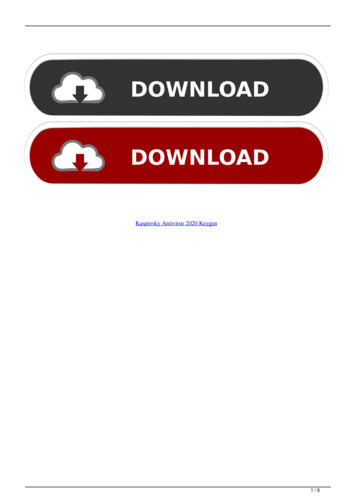
![Kaspersky Antivirus 6.0.4.1424. Key File 18 [REPACK]](/img/59/maramon.jpg)


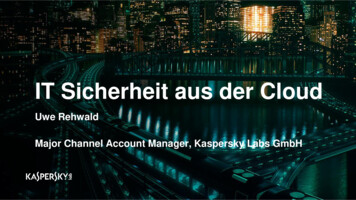
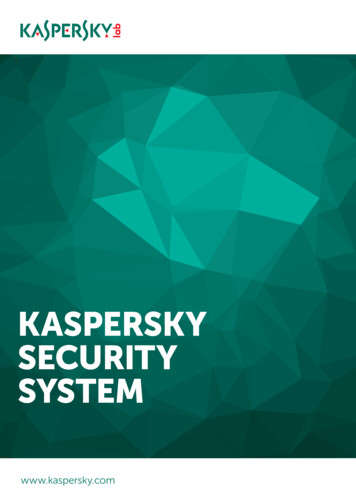
![Kaspersky Password Manager 9.0.1.447 Crack [BETTER]](/img/55/kaspersky-password-manager-901447-crack-better.jpg)
